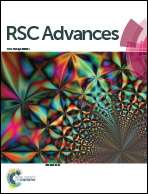Salt doping to improve thermoelectric power factor of organic nanocomposite thin films†
Abstract
Thermoelectric materials with a large Seebeck coefficient (S) and electrical conductivity (σ) are required to efficiently convert waste heat into electricity, but their interdependence makes simultaneously improving these variables immensely challenging. To address this problem, bilayers (BL) of poly(diallyldimethylammonium chloride) (PDDA) and double-walled carbon nanotubes (DWNT), stabilized by KBr-doped poly(3,4-ethylenedioxythiophene):poly(styrene sulfonate) (PEDOT:PSS) were deposited using layer-by-layer (LbL) assembly. Doping PEDOT:PSS with KBr, prior to DWNT dispersion and LbL assembly, results in a six-fold improvement in electrical conductivity with little change in the Seebeck coefficient. A maximum power factor (PF = S2σ) of 626 ± 39 μW m−1 K−2 is obtained from a 20 BL PDDA/PEDOT:PSS–DWNT film (∼46 nm thick), where PEDOT:PSS was doped with 3 mmol KBr. This large PF is due to the formation of a denser film containing a greater proportion of DWNT, which was influenced by the charge-screening effects imparted by the salt dopant that separates PSS from PEDOT. This study demonstrates a relatively simple strategy to significantly increase the thermoelectric performance of fully organic nanocomposites that are useful for low temperature thermoelectric devices.



 Please wait while we load your content...
Please wait while we load your content...